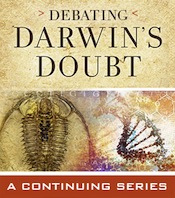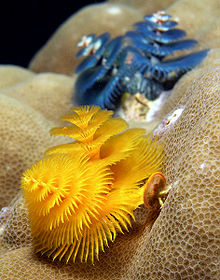 Evolution
Evolution
 Intelligent Design
Intelligent Design
Cambrian Animals? Just Add Oxygen
 As if seeking to preempt Stephen Meyer’s book Darwin’s Doubt: The Explosive Origin of Animal Life and the Case for Intelligent Design, Darwinian scientists have been scrambling to publish new explanations of the Cambrian explosion.
As if seeking to preempt Stephen Meyer’s book Darwin’s Doubt: The Explosive Origin of Animal Life and the Case for Intelligent Design, Darwinian scientists have been scrambling to publish new explanations of the Cambrian explosion.
Six biologists from Harvard and Scripps (and one from India) have lobbed the latest entry into the contest to explain the Cambrian explosion from Darwinian assumptions. It is “Oxygen, ecology, and the Cambrian radiation of animals,” published in PNAS. We’re not sure if this one passes the laugh test.
Facing the Facts
They get one thing right: most animal body plans appeared in a geological instant, and no Darwinian evolutionist has ever explained it:
The Proterozoic-Cambrian transition records the appearance of essentially all animal body plans (phyla), yet to date no single hypothesis adequately explains both the timing of the event and the evident increase in diversity and disparity….
Cambrian fossils chronicle the appearance of essentially all high-level animal body plans, as measured by cumulative first appearances of metazoan phyla and classes, in a geologically brief interval between ?540 and 500 million years ago. (Emphasis added.)
Oh, they mention attempts to explain it: external forcing (like rising oxygen levels), for one. This can explain the timing (they think), but not the innovation itself:
There is no theoretical reason why ocean redox should generate the evolutionary novelties — specifically the fundamental new bauplans — seen in the Cambrian fossil record.
For another, there are ecological hypotheses that focus on interactions among organisms. These can explain the innovation (they think), but not the timing:
They can also explain the origin and maintenance of high-level body plan disparity through the principle of frustration: organisms optimally suited to one task will be less well suited for another, leading to a roughening of the fitness landscape and isolation of distinct fitness peaks….
A carnivory-based ecological hypothesis, then, can explain the pattern of morphological diversification seen in the Cambrian fossil record but does not directly address its timing.
In other words, the explosion could have occurred tens or hundreds of millions of years earlier. Why did it go bang about 540 million years ago?
Secret Sauce
So what is the secret sauce these researchers have cooked up? Why, it’s a mixture of the two competing approaches into an “integrated causal hypothesis” that gives credit to both ecological and environmental factors. Here’s the scenario: after a billion years of microbe evolution, oxygen levels on the ocean floor rise to “allow” or “permit” higher energy organisms to evolve. Once they evolve, “carnivory” begins. Once carnivory begins, the carnivores need bigger bodies to hunt and eat prey. The evolutionary arms race is on!
Rising oxygen levels would have allowed larger body sizes, but more importantly from a macroevolutionary standpoint, the first active, muscular carnivores…. Escalatory arms races driven by these newly evolved carnivores could then explain the relatively rapid expansion of metazoan diversity and disparity near the beginning of the Cambrian Period.
Where did these “newly evolved carnivores” (with lots of muscles) come from, you ask? Well, they just appeared:
Consistent with this hypothesis, the origin of carnivory itself appears to be temporally correlated with the Proterozoic-Cambrian transition (Fig. 1), a prerequisite if predator-prey “arms races” are to be viewed as the driving forces behind morphological innovation.
So, carnivores appeared, flexing their muscles. They had to. “Morphological innovation” needed a driving force. Along with muscles, evolution provided new digestive tracts, senses, behaviors — whatever “morphological innovation” the carnivores needed. The hidden hand of evolution had lots of time to prepare for their advent:
This focus does not obviate a role for developmental genetics, but because most gene families that govern bilaterian development originated well before Cambrian body plan diversification, the prime role of development was in assembling these preexisting genes into coherent networks to build body plans suited to the evolving Cambrian fitness landscape.
The bold words in the passage above help themselves to the vocabulary of intelligent design. Darwinism does not allow roles. It doesn’t permit governors. It doesn’t assemble networks. Natural selection is incapable of building things according to a plan. From a Darwinian standpoint, the passage is utterly incoherent.
Let’s Get Empirical
 Every scientific paper needs some kind of appeal to evidence obtained by observation, however obscure it might be. These scientists looked at modern sea-bottom communities with low-oxygen conditions and, after sufficient tweaking of definitions, counted carnivores. They only counted polychaetes — annelid worms with feathery appendages for either filtering or catching food — dodging the embarrassing fact that polychaetes are among the novel body plans that appeared in the Cambrian explosion.
Every scientific paper needs some kind of appeal to evidence obtained by observation, however obscure it might be. These scientists looked at modern sea-bottom communities with low-oxygen conditions and, after sufficient tweaking of definitions, counted carnivores. They only counted polychaetes — annelid worms with feathery appendages for either filtering or catching food — dodging the embarrassing fact that polychaetes are among the novel body plans that appeared in the Cambrian explosion.
Sure enough, they found a trend toward more carnivory with increasing oxygen. There was significant overlap in the data, though, and some significant outliers that bucked the trend. Whether 21st-century polychaetes have anything to tell about Cambrian ecology, however, is questionable:
Although these analyses focus on oxygen, we recognize that other environmental parameters and physiological stressors may be important in shaping the biology of modern OMZs [oxygen minimum zones]…..
Other factors besides carnivory and oxygen may have been important, but many of them are related to carnivore evolution itself (e.g., the evolution of sensory apparatus and vision).
Hold on. Stop right there. The “evolution of sensory apparatus and vision”? How did that happen? Any sufficiently question-begging syntax is indistinguishable from magic.
Information, Please
Once again, we see Darwinists dodging the main problem with the Cambrian explosion: the sudden appearance of biological information necessary to build tissues, organs, limbs, eyes, systems, and body plans. This is the focus of most of Part II of Stephen Meyer’s book Darwin’s Doubt. Mystically, they imagine animals as eager to evolve but, like racehorses at the gates, held back by environmental barriers:
Such an environmental shift could remove a barrier to animal evolution, but aside from direct links to maximum permissible body size, it lacks an explicit mechanism to generate diversity (new species) and disparity (new body plans).
That sentence shows that they know better. They know one cannot assume that an opportunity to evolve will generate innovation. One cannot assume that an environmental or ecological “trigger” will propel animals on the race up Mount Improbable. Evolution lacks a mechanism to generate body plans. The information required to plan and build complex animals is a fundamental challenge to those who trust in unguided, aimless, purposeless natural processes.
Intelligence, by contrast, can assemble codes into coherent networks. Intelligence can direct elements into roles in a hierarchy. We never sees unguided processes achieving such ends. From our uniform experience, we can reason that intelligence was required to “govern” new cell types into their “roles” as tissues, organs, and systems in an overall body plan.
Pie in the Sky
A tradition in papers like this is to tag on a promissory note at the end. The researchers present a hint of a suggestion of a notion of a possibility of an idea, about which further research is needed:
Continued exploration of the causes, timing, and magnitude of oxygenation will provide further insight into the role of oceanographic change in the evolution of carnivory and this unique geobiological event. Further study of the relationship between feeding ecology and oxygen in modern OMZs, as well as the coevolutionary history of animals and ocean redox state in deep time, may also help us predict future changes associated with ocean deoxygenation and expanding oxygen minimum zones.
“Further insight” presupposes that insight greater than zero has already been offered, but it hasn’t. This paper is less about the evolution of carnivory than about the evolution of excuses for maintaining Darwinism despite the evidence of the fossil record — a problem of which Darwin himself was painfully aware, that has only grown worse in the 154 years since The Origin.
Image: Christmas tree worms (Spirobranchus giganteus)/Wikipedia.
